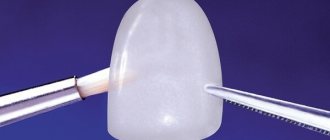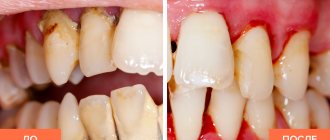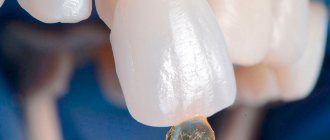A dental crown is a separate type of orthopedic structure used in dentistry to restore the shape, aesthetics and functional functions of a dental unit. Single crowns are used in the process of restoring severely damaged teeth: for example, if due to illness or injury the natural crown has been destroyed by more than fifty percent, it is more correct to restore it not with filling composites, but by installing a dental crown. Dental crowns are also actively used in prosthetics, for the restoration of missing units. Most often, a dental bridge is used for this purpose - a structure in which several dental crowns are connected. The finished prosthesis is fixed in the oral cavity on the supporting teeth, previously prepared to the thickness of the crowns. Bridges are used when there is a defect in a row with the absence of no more than two dental units in a row.
Calculate the cost of treatment by taking a short test in 20 seconds!
Do not delay your treatment, because in this matter time plays against us.
Photos of a single crown and dental bridge will help you get an idea of what the structures look like.
Before restoration with crowns, not only preliminary grinding of the supporting teeth is required: the teeth should be treated for carious damage, restored with a filling, and sometimes endodontic treatment may be required. Professional sanitation of the oral cavity is also recommended. All of the above measures allow restoration with crowns to be carried out with the highest possible quality, without the risk of complications in the future.
When is it indicated to install crowns on teeth?
The main indications for installing dental crowns are as follows:
- Severe destruction of the dental unit, in which the natural crown of the tooth has collapsed by more than fifty percent;
- In case of single defects in the dentition (when no more than two units in a row are missing in a row);
- Aesthetic restoration to achieve an attractive tooth color and shape.
Less commonly, crown prosthetics act as an alternative to orthodontic treatment in situations where it is necessary to change the position of one tooth in a row.
USEFUL TO KNOW: Teeth that are more than 50% damaged due to caries or for other reasons should be restored with a crown, not a filling. Large fillings installed quickly on pins fall out, and in addition, teeth filled under such circumstances usually come out of the bite, which can lead to its failure and disruption of the correct distribution of the chewing load.
An even worse option is that a tooth with a huge filling simply cannot withstand the pressure that occurs when chewing food and breaks, and if a pin is placed, the root of the tooth unit may also be damaged. Trauma to the tooth root suggests only one outcome - tooth extraction.
Prosthetics with crowns has not only indications for implementation, but also contraindications, which are important to exclude before starting the treatment process. Crowns are not installed:
- With mobility of the dental unit;
- Abnormally low height of the natural coronal part of the tooth, leading to the collapse of the orthopedic crown;
- When there are a significant number of teeth in rows.
It will be necessary to postpone restoration with crowns even if the diagnosis reveals an inflammatory process in the upper part of the root system of the tooth or poor-quality filling of its canals.
Under such circumstances, it will be necessary to take measures to eliminate temporary contraindications to crowns and only after that the restoration procedure itself.
What are dental crowns
This is an artificial denture that is installed on a pre-treated natural crown. The purpose of prosthetics is to restore the anatomical shape, aesthetic appearance, and chewing function. Crowns can also be part of some other orthopedic structure: support for a partial removable or fixed denture, splinting for loosening of the dentition, etc.
Crowns on teeth
The design must meet certain requirements:
- restore the anatomical shape of the tooth, its aesthetics and color;
- support chewing and speech function;
- fit well to the neck of the destroyed tooth, make correct contact with neighboring units, as well as with teeth on the opposite side, without creating an obstacle to the closure of the dentition;
- do not interfere with the motor activity of the lower jaw;
- do not cause allergic reactions or tissue irritation.
All designs of this type have their pros and cons.
pros
Of all types of dentures, this one has a number of positive qualities, in some cases giving advantages over other types of prosthetics:
- rapid restoration of appearance and chewing function;
- large selection of materials for prosthetics;
- correct distribution of the load, eliminating the risks of abrasion of adjacent teeth and malocclusion;
- prevention of destruction of periodontal tissues and atrophy of jaw bone tissue;
- the ability to install several prostheses at once;
- if the root is partially destroyed, it is possible to install the prosthesis on a pin; if there is a complete absence of a root, it can be installed on an implant (titanium root).
Minuses
Negative qualities:
- the need to grind a tooth, sometimes a healthy one, if it performs a supporting function;
- a short period of discomfort after installation of the prosthesis; with the correct selection of material and compliance with installation technologies - very short;
- allergic reactions to certain dental materials;
- possible complications are reduced to a minimum with proper prosthetics;
- high cost of high-quality materials and insufficiently good appearance of cheap ones.
Dental crowns: classification, overview of characteristics and prices for different types of crowns
The classification of dental crowns is carried out according to the material of production. Crowns made of metal alloys of various metals are in maximum demand: they are durable and at the same time have an affordable price for most patients. However, let us make a note - crowns made from alloys of ordinary metals - cobalt, chromium, nickel - will be inexpensive. Crowns made of precious metals are much more expensive and the price of the products will be directly related to their weight.
No less popular types of crowns are structures made of dental ceramics, which include crowns made of zirconium, porcelain, and lithium disilicate. Each type of product has its own unique performance characteristics, which will be useful to learn about in advance, if only because they will have an active influence on the price of the crown.
The cost of a crown per tooth varies from one dentist to another. At the current time, the price of a crown per tooth unit will be:
- Metal-ceramic crown - from 5 to 16 thousand rubles;
- Ceramics - from 16 to 25 thousand rubles;
- Metal crowns - about 5 thousand rubles.
USEFUL TO KNOW: Of course, the price of crowns may seem high, but it is wrong to think that it is so high only because dentists want to profit from patients. The cost of a crown depends on the cost of the material for its production and the complexity of the manufacturing technology. And the production material and technology - the strength of the crown, the timing and comfort of its operation will depend on these factors.
For example, the most inexpensive option is all-metal crowns. However, the aesthetics of such structures are extremely poor; they are practically not used for restorations in the smile area. Therefore, when choosing a crown, you should focus primarily not on the price, but on the result of the restoration you want to achieve. If aesthetics and the durability of the crown are important to you, you should choose crowns made from more expensive materials produced using computer modeling technologies. If the masticatory unit is restored with a crown, you can save money and choose a high-quality and at the same time budget option for the prosthesis.
Below we will consider in detail the features of different types of crowns and find out their approximate cost.
Types of crowns
The number of missing teeth, the presence of dentures and other individual characteristics of the patient determine what type of crown is suitable for him. It is impossible to determine this in absentia, since it requires an examination by a specialist.
Bridges
Suitable for people who have lost more than one tooth. The prosthesis is made for all missing units, and its parts are connected by a metal bridge. To secure the crowns, you need healthy chewing teeth. Only complex prosthetics are performed in this way.
Implant supported crowns
If the patient has implants, the crown can be secured to them. This will prevent the destruction of healthy teeth, which can occur due to excess stress. But the method is only suitable for those who already have implants installed.
Crown for one tooth
If one tooth is destroyed, a crown can be installed only on it. This usually happens after deep caries or injuries. Before installing a crown, the condition of the periodontium, jaw and gum tissue is assessed. Sometimes additional operations are performed to build up the bone plate.
Fixation with a pin
The rarest method of prosthetics is installing a crown on a pin. It is quite traumatic and carries a risk of complications, so it is almost never used. If other methods of prosthetics are not available to the patient, the crown is installed on a pin, but this is done in several stages under the supervision of specialists at each of them.
Metal-ceramic crowns: features, cost of prosthetics
The basis of this type of crown is a solid metal alloy frame, the average thickness of which is about 0.5 millimeters. From the outside, the metal base is covered with several layers of ceramic mass, which allows you to obtain an aesthetic appearance of the prosthesis, visually indistinguishable from natural teeth. The base can be made from both inexpensive metals and precious metals - gold and platinum.
USEFUL TO KNOW: In terms of price, a platinum crown is only slightly cheaper than a metal-free product, but at the same time its aesthetic indicators are lower, since even the precious metal will shine through the ceramics.
The advantages of metal-ceramic crowns include: reliability and durability, good aesthetics, affordable price (if we are not talking about products made of platinum or gold). The disadvantages of metal-ceramic crowns will be the following: before prosthetics, a significant amount of tissue is removed from the supporting teeth, teeth often need to be depulped first, and the gum tissue around the crown can acquire an unsightly bluish tint. This defect in metal-ceramic crowns is especially noticeable and critical when performing prosthetics in the smile area.
USEFUL TO KNOW: The defect of cyanosis of the gums occurs due to contact of the crown with soft tissues. To avoid the occurrence of such an unpleasant phenomenon, you can order in advance the production of a prosthesis with a shoulder mass, in which the lower part of the base of the product is also covered with a layer of ceramics. Prostheses with shoulder mass have a more complex production technology, and therefore their price is higher than for conventional crowns.
Having understood the features, advantages, and disadvantages of metal-ceramic crowns, we can move on to considering their cost. On average, a crown of this type, made of high-quality alloy, will cost about 8,000 rubles. If expensive ceramic materials are used for veneering the crown, allowing for high aesthetics of the product, the price of the crown will be higher and can amount to 10 thousand rubles.
The price of crowns with shoulder mass will be even higher - from fourteen thousand. Prices for metal-ceramic crowns may be lower - 5-6 thousand rubles, but usually at this price they offer products in the production of which domestically produced materials were used. Let’s be honest, the domestic product does not meet European quality standards, and therefore the finished crowns will not be distinguished by high levels of aesthetics and reliability.
Crowns with a base of gold or platinum cost about 10 thousand rubles. But the indicated amount is the cost of manufacturing the prosthesis, to which should be added the price of the precious metal per gram of weight. As a result, the price of the crown is already a different amount - from 18 thousand rubles.
It is important to note: the price of crowns does not include pre-treatment services and the cost of a temporary prosthesis.
Which crown is better: rating
Below we will talk about the best options for prosthetics of chewing teeth in different clinical situations. In Table 1 you can see which crown is better in situations where only single crowns are needed, or when we are talking about restoring a missing tooth with a bridge. The types of crowns in the table are listed from best to worst.
Dental crowns: which ones are best for chewing teeth (Table 1) –
| Single crown | Bridge prosthesis | |
| 1. | pressed ceramic E.max | made of zirconium dioxide |
| 2. | made of zirconium dioxide | combined bridge * |
| 3. | metal ceramics | metal ceramics |
| 4. | solid crown | solid bridge |
* This prosthetic option involves a combination of metal-ceramic and solid-cast bridge prosthesis. So, if from the table it has already become clear to you which crown is best to place on chewing teeth, then below you will find a detailed description of the pros and cons of the above types of crowns in various clinical situations.
1) Crowns/bridges made of zirconium dioxide –
Zirconium dioxide is a metal-free ceramic. This type of ceramic has very high strength (more than 900 MPa), which is comparable to the strength of metal, as well as a higher level of aesthetics - compared to metal ceramics. If you need to make a bridge on the chewing group of teeth, then a zirconium dioxide bridge will be the best option. But if you need to make a single crown, then zirconium is inferior to pressed glass ceramics E.max.
Pressed glass ceramics E.max has: 1) better aesthetics, 2) it has a lower risk of chipping the ceramic mass, but it cannot be used to make bridge-like prostheses resting on the distal chewing teeth. Therefore, if at least one of 6-7-8 teeth must act as supports for a bridge, the only ceramic option will be zirconium dioxide. If you need a single crown, read the next section about E.max ceramics.
Important: Most often, zirconium dioxide crowns/bridges consist of two layers. First, the zirconium frame of the future crown/bridge is milled on a computer-controlled machine (similar to the metal frame of metal-ceramics). After firing in the kiln, layers of porcelain in different shades are applied to this frame to match the color of the adjacent teeth.
The second manufacturing option is that crowns/bridges are made from monolithic zirconium dioxide (without subsequent application of porcelain layers). This option has a big advantage - there is absolutely no risk of ceramic chipping, but the aesthetics will be worse. According to statistics, when making zirconium crowns with surface application of porcelain, ceramic chips occur in approximately 10% of patients after 6 years of using such crowns.
At the same time, studies show that the risk of ceramic chips in metal-ceramic crowns is approximately 2 times lower (than in zirconium crowns with a surface layer of porcelain). And the risk of chipping with pressed E.max glass ceramics will be even lower. Therefore, to the question: which crowns are best placed on chewing teeth, the answer is that bridges are best made from monolithic zirconium dioxide, and single crowns from E.max.
→ Cost of zirconium dioxide crowns/bridges
2) Crowns made of pressed ceramics E.max –
Two single crowns from E.max – before and after photos
E.max glass ceramics are the best option for metal-free ceramics if you have the highest demands on the aesthetics of your crowns. This type of ceramic has a high strength of 400 MPa (which is less than that of zirconium dioxide), but this is more than enough for prosthetics of posterior teeth with single crowns. But for the manufacture of bridges supported by 6-7-8 chewing teeth, this strength will no longer be enough, and therefore bridges from E.max are made more often for the front teeth.
E.max comes in two main types. Firstly, this is the “E.max PRESS” material, intended for the manufacture of crowns/bridges using the pressing method at high temperature and pressure. Let's say right away that this material is much better and somewhat cheaper than the second one. Secondly, the “E.max CAD” material, which is intended for the manufacture of crowns using the milling method (CAD/CAM technology, which is also used for the manufacture of zirconium crowns).
Important: E.max crowns/bridges can be (as well as zirconium) made either monolithic or consist of 2 layers - a pressed frame on which porcelain mass will be applied. Monolithic structures have the lowest risk of ceramic chipping, while layered structures have the best aesthetics. Not long ago, a new material “E.max PRESS Multi” appeared, which makes it possible to make very aesthetic monolithic structures, from which we recommend making all single crowns for chewing teeth.
→ Cost of crowns/bridges from E.max
3) Metal-ceramic crowns/bridges –
A more budget-friendly option is metal-ceramic prosthetics. Its main aesthetic disadvantages are more modest aesthetics (compared to metal-free ceramics), the development of cyanosis of the gums around the crown, and also, over time, gum recession with exposure of the metal edge of the crown. But on the other hand, chewing teeth are not visible when you smile, which, given a limited budget, makes metal-ceramics a good choice.
Below we have posted examples of prosthetics for missing chewing teeth using metal-ceramic bridges (before and after photos).
But aesthetics should not be the only selection criterion. The fact is that for metal-ceramics, teeth are ground on different sides by 2.0-2.5 mm, and for metal-free ceramics - only 1-1.5 mm. Thus, ceramic prosthetics allows you to preserve more hard tooth tissue under the crown, which increases its service life. The cost of one metal-ceramic crown starts from 8,000 rubles (for the most budget-friendly manufacturing option, using the cheapest materials made in Russia and Belarus).
On average, for a budget option using imported economy-class materials (for example, Duceram ceramic mass, Germany) - it costs from 10,000 to 12,000 rubles for 1 crown. If the issue of aesthetics is important to you, then the production of metal-ceramics using high-quality and expensive ceramic masses Vita (Germany), Noritake (Japan), Ivoclar (Liechtenstein) will cost at least 15,000 rubles for 1 crown. It is also worth considering that the indicated price does not take into account some additional costs.
→ Calculation of the cost of metal ceramics
4) Solid crowns/bridges –
Crown bridges on the back teeth (which do not fall into the smile line) do not have to be white and beautiful. There are metal cast crowns that are made of chromium-cobalt alloy. Such crowns have the color of polished metal, or by spraying they can be given a “gold” color. They have a long service life, and besides, the teeth under them are ground to a lesser extent than under metal-ceramics.
→ Calculation of the cost of cast crowns
5) Combined bridges –
If you need to make a bridge of 3 crowns on the chewing teeth (for example, supported by the 5th and 7th teeth), the design can be made in an unconventional way... The first 1-2 crowns that fall into the smile line can be made metal-ceramic, and the distant ones 1-2 crowns can be made solid and look like polished metal. This will be somewhat cheaper, and besides, it turns out that the abutment tooth for a cast crown will be ground down to a lesser extent.
Ceramic (metal-free) crowns: overview of types, performance properties and prices
The main difference between such crowns and metal-ceramic analogues is that they are produced without a cast metal alloy frame and this gives two advantages at once: high aesthetics and the possibility of using crowns in patients with allergies to metals. The aesthetic and most natural appearance is ensured by the translucency of the ceramic; according to this property, the material will be almost identical to natural tooth enamel.
USEFUL TO KNOW: Opaque ceramic masses are used for veneering metal-ceramic crowns, and therefore the finished crown will look somewhat unnatural.
Ceramic crowns can be made from zirconium dioxide or E.max glass ceramics. Both crown materials have high levels of transparency and therefore products made from them will look natural and visually indistinguishable from natural teeth.
What dentures are best for the front teeth?
Since the teeth in the smile area are visible to others, high aesthetic demands are placed on prosthetics in this area. In this regard, it is better to install prostheses made of zirconium dioxide (aluminum oxide), metal ceramics or all-ceramic crowns on the front teeth.
Caps made of solid ceramics are put on the upper incisors; they look good and are not subject to heavy loads. Products are made from medical porcelain using injection molding.
The lower incisors and canines bear a significant load, so in this case, solid ceramics are replaced with zirconium dioxide. The durable frame is coated with a ceramic layer to create a reliable and attractive prosthesis for the front teeth.
In addition, zirconium dioxide is successfully used when installing dental bridges in the smile area.
Zirconium crowns
An innovative CAD/CAM manufacturing technique is used to produce zirconium dioxide crowns. It allows the production of orthopedic structures with minimal human intervention. Crowns are turned using milling equipment, and their layout is made using special computer technologies.
Zirconium is a unique material; it not only has optimal biocompatibility with the human body, but also high strength, comparable to the strength of metal. The cost of zirconium crowns starts from 16 thousand rubles.
Two types of zirconium crowns can be used for restoration and prosthetics:
- Two-layer, that is, consisting of a zirconium frame, which is subsequently covered with ceramic mass. The use of this type of crown allows you to obtain the most aesthetic result of restoration, but there is also a minus - if used incorrectly, the ceramics from the frame may chip and the prosthesis will have to be restored;
- Monolithic crowns are machined from solid zirconium blocks and do not have a porcelain outer layer, but in terms of aesthetics they will be significantly inferior to the first type of product.
If prosthetics are performed in the area of the front teeth, where aesthetics are important, glass-ceramic crowns may be the best choice.
Methods for making a crown
Orthodontic products can be manufactured using several methods. Each of them has its own advantages and disadvantages.
Cast products
Strong and durable crowns are made using casting. For this, a single piece of metal is used. The method is not suitable for all materials.
Stamped
More affordable, but less durable prostheses are made by stamping:
- a mold is placed into the dental anvil;
- using rubber rings a stamp is obtained;
- the crown is made using special hammers that differ in shape and size;
- The product is given its final shape using small tongs.
Such crowns last less than cast ones, but are much cheaper to produce.
Glass-ceramic crowns E-max
Glass-ceramic crowns are an excellent option for those who want to get the most aesthetic results from prosthetics. The cost of one E-max crown is from twenty thousand rubles.
Despite all the advantages, glass-ceramic crowns have one significant disadvantage: they are applicable only in the case of single defects in the dentition. A bridge can also be made from glass-ceramics, but with no more than three crowns, and it is fixed in the area of the front teeth. These limitations are associated with the strength of glass ceramics, which will be insufficient for a massive bridge, which will also be subject to significant load (during the restoration of chewing units).
Single glass-ceramic crowns can be used for prosthetics of any teeth - front and chewing. Such crowns can be monolithic or two-layer; any type of product is produced using computer modeling technology.
Caring for dental crowns after prosthetics
How long the installed structure will last depends not only on the quality of dental services, but also on proper care. After installing a crown, it is important to follow these recommendations:
- You will be able to eat 2 hours after installation of the prosthesis, and drink immediately;
- For the first few days, it is better to chew solid food on the opposite side; over time, the load can be increased, but you should no longer chew nuts at all;
- after installing prostheses made of plastic or metal-ceramics, it is better to avoid taking coloring foods: coffee, beets, red wine, etc.;
- after each meal you need to rinse your mouth, using an irrigator to rinse the interdental spaces; It is better not to use dental floss, as they can damage the denture;
- brush your teeth twice a day with a soft toothbrush and toothpaste without abrasive particles; President pastes with an RDA abrasiveness rating of less than 50 units are suitable. (Preggy for pregnant and nursing mothers and Junior).
Crown care products
Cast crowns
The main material for the production of cast crowns is an inexpensive alloy of cobalt and chromium; their surface looks perfectly smooth and even, like well-processed and polished metal. If desired, you can do a finishing gold plating. Cast crowns have good durability and wear resistance, a budget price, but extremely low aesthetics. The average cost of a cast crown is five thousand rubles.
Cast crown products are a good option for prosthetics in the area of chewing teeth; they do not require significant grinding of the teeth that support the fixation of the prosthesis. If such crowns are placed in the smile area, they can be additionally lined with special plastic overlays to achieve greater aesthetics.
Metal-plastic crowns
Such prostheses are called conditionally temporary crowns. A cost-effective prosthetics option that involves installing crowns with a metal base and a plastic coating. Traditionally, structures are made of nickel, cobalt, and chromium.
Despite the natural appearance and relatively good functionality, it is not worth wearing such prostheses for a long time: the product quickly loses its whiteness, slightly increases in size and needs to be replaced.
Among the undeniable advantages of metal plastic are its low cost and gentle effect on the enamel layer of the tooth. If the product is slightly deformed, it can be repaired directly in the patient’s mouth. Among the disadvantages of this choice, it is worth highlighting the low strength of the structure and the likelihood of developing allergies.
Stamped crowns
In modern dentistry they are used extremely rarely, since they have few advantages, but a significant number of disadvantages. Stamped crowns are produced from a special type of blank - metal sleeves. Such a crown can be made with gold or silver plating.
As mentioned above, crowns using the stamping method were valued for their low price and the absence of the need to sharply grind the supporting teeth, but stamped crowns do not have an aesthetic appearance, quickly deform, and do not fit tightly to the neck of the tooth, which is why residues can get under the crown food, saliva and, naturally, pathogenic microflora. Caries under stamped crowns was not uncommon!
Alternatives to crowns –
However, we must not forget that there are alternatives to artificial crowns. In addition to crowns, traditional tooth filling (with preliminary fixation of a pin in the root canal) can be used to restore a severely damaged tooth, and an implant can be used to restore a single missing tooth.
Which is better: a filling or a crown, a pin or a crown?
When the crown part of a tooth is significantly damaged, it can be restored not only with a crown, but also with the help of filling materials. However, there is a clear rule: if the crown of a tooth is destroyed by more than 1/2, the tooth must be restored with an artificial crown. This is especially true for pulpless teeth (from which the nerve was removed), because Such teeth become very fragile and often cannot withstand chewing pressure.
But, if the crown of the tooth is destroyed by less than 1/2, then you can use the method of restoring the tooth with filling material. If such a tooth is pulpless, then a metal or fiberglass pin is fixed in one of the root canals, which will ensure a more reliable fixation of the filling. However, keep in mind that under no circumstances should a filling with a pin be used to restore teeth whose crowns have been destroyed by more than 1/2. This is almost a guarantee that over time a fracture of the crown or root of the tooth will occur.
Restoring a completely destroyed tooth - if the crown of the tooth is completely destroyed, but if the root is strong, this is not yet a reason to remove the tooth. In such cases, restoration of the coronal part of the tooth is carried out using a stump inlay, onto which an artificial crown is subsequently fixed.
Which is better: a crown or an implant?
When it comes to replacing missing teeth with crowns, an alternative to a traditional bridge can be installing an implant. The latter has a lot of advantages over the bridge, because in this case, you will not have to grind down adjacent teeth for crowns, thereby reducing their service life.
Moreover, the cost of installing 1 economy-class implant is almost equal to the cost of a metal-ceramic bridge (especially taking into account the cost of preparing teeth for prosthetics and making temporary plastic crowns). A bridge will be better than an implant only in one situation - when the teeth adjacent to the missing one have large fillings or are pulpless (i.e., in any case, they require strengthening with artificial crowns).
Gold crowns
Gold crowns are not installed in every dentistry - working with precious metals requires a special license, which is quite difficult to obtain. Moreover, the cost of a finished gold crown is equal to the price of a more aesthetic ceramic crown, so it is unlikely that you will be able to save money on installing gold dentures.
The price of a gold crown will be calculated as follows: the price of the precious metal in grams is added to the cost of manufacturing the prosthesis. The total amount of precious metal that goes into the production of the crown is taken into account. How much metal is required is a difficult question to answer; it all depends on the tooth, its position in the row, and the anatomical features of the structure.
Optimal conditions for prosthetics
Depulpation in dentistry is the procedure for removing the neurovascular bundle (pulp) from the root canals.
This manipulation is performed before prosthetics, but is not always mandatory. The need for such a procedure is determined by the doctor after assessing the condition of the problem unit.
Prosthetics of a vital tooth is possible if the following indications are identified:
- The element is healthy, but its anatomical structure does not allow it to fully perform its functions (the tooth is excluded from the chewing process, or, on the contrary, it experiences excessive chewing load).
- Unaesthetic appearance due to any acquired or congenital anomaly.
- The enamel coating in a certain area is very sensitive and subject to rapid abrasion.
- There is a need to use a healthy organ as a support to secure the bridge.
Only with such indications is a decision made to preserve the neurovascular bundle. This allows you to fully preserve the nutrition of all tissues of the covered unit.
Depulpation is necessary if the crown will be fixed to a healthy element of the frontal section. All front teeth are single-rooted, and the nerves are located close to the surface, which means that when grinding it is easy to damage the pulp and cause tissue burns.
In multi-rooted teeth, the neurovascular bundle is located deep, and they can be left “alive”, since the likelihood of a burn is minimal.
Multi-rooted elements of the dentition may be left non-pulpless.
Let's figure out together which crowns are best placed on implants and why.
Come here if you are interested in the reasons for the appearance of blood from under the crown.
At this address https://www.vash-dentist.ru/protezirovanie/nesemnyie-p/koronki-np/shhel-mezhdu-desnoy-trebuet-terapii.html we will explain what to do when the gums have risen above the crown.
Metal-plastic crowns
Another name for this type of crowns is combined. The structural structure of the crowns is as follows: a cast metal alloy frame, which is additionally covered with a white plastic mass. The advantage of combined crowns is an affordable price, as well as acceptable aesthetics. The average cost of metal-plastic crowns starts from five thousand rubles.
However, combined crowns have a number of disadvantages that are definitely worth considering:
- The plastic finish of crowns very quickly loses its visual appeal; it may turn gray or yellow. Plastic tends to absorb moisture from the external environment and therefore the plastic layer swells and an unpleasant aroma begins to emanate from it;
- Combined crowns do not have high strength indicators; they can break due to excessive loads; most often, during the chewing process, it is the finishing plastic lining that falls off.
Plastic has fairly low biocompatibility rates, so metal-plastic crowns are not recommended for installation by people prone to allergic reactions.
Some nuances
After depulpation, the tooth becomes fragile due to its “switching off” from the metabolic process. Excessive stress when eating food can also lead to premature loss. Due to these circumstances, prosthetics without depulpation has gained considerable popularity among patients.
The procedure itself is associated with certain difficulties. The main nuances of this process are:
- The need to use a large amount of water when grinding the tooth surface. This technique will protect the pulp from overheating (excessive heat exposure).
- Use of a special tip.
- Use only new bur in the work. If the cutting part of the bur has already been used before, difficulties arise when grinding down the dentin, which will lead to rapid heating of the nerves, and as a result, their death.
- Upon completion of the procedure, application of a protective coating to prevent infection from entering the neurovascular bundle.
- The need to use special solutions containing antiseptics to improve the fixation of crowns.
Important! Failure to comply with these requirements may result in further complications and additional need for treatment.
In addition, upon completion of the preparation procedure, a temporary crown is necessarily attached to the tooth. This requirement solves several problems simultaneously:
- Full preservation of chewing function.
- Hiding an aesthetic defect, especially if reconstruction is planned in the frontal area.
- Preventing the development of pain that the patient may feel if he chews on the problem area.
- Providing psychological comfort.
- Protection of the stump and periodontal tissues from pathogenic microorganisms.
- Prevention of loosening and shifting of teeth after grinding due to loss of support in the form of a nearby element.
- Preventing changes in gum shape.
- Getting used to constantly wearing the future prosthesis.
- Ensuring correct pronunciation of sounds.
Combined dental bridges with crowns made of different materials
Bridges for crowns made of metal-ceramics and crowns made of metal are made on the same base - on a frame cast from a metal alloy, and therefore crowns from different materials can be combined on a bridge of this type. For example, crowns that fall into the smile zone can be made from more aesthetic metal-ceramics, while crowns that are invisible to others can be made from metal.
The work on manufacturing a combined bridge will not be highly complex, but the overall cost of prosthetics with crowns will decrease, which is not always adequately perceived by doctors seeking to make money on their patients. If you are assured that a combined bridge with crowns cannot be made in your case, you are being deceived and it probably makes sense to go to another dentistry, where the patient’s wishes are perceived and taken into account.
Preparation for prosthetics
Preparing to install a dental crown is a long process, but necessary if you want the denture to last for many years and not cause any discomfort. Classical training takes place in 7 stages.
- Examination by an orthopedist
The doctor can give an opinion on the advisability of prosthetics using a dental crown at the initial appointment after a thorough examination of the oral cavity. He will assess the condition of your teeth and gums. Offer an individual treatment plan. Will inform you about which crown material is preferable in your particular case. He will select the optimal color for the future crown so that it cannot be distinguished from natural teeth. Finally, he will calculate the final cost of the service and the deadline for its completion. - X-ray
Having a targeted X-ray image of the problem tooth is the main condition when preparing for prosthetics. Based on the data obtained from it, the dentist will be able to decide whether it is in principle possible to restore the tooth with a crown or whether it is worth looking for alternative solutions to the problem. - Therapy
The third fundamentally important stage is the treatment of all foci of infection in the oral cavity. Before installing a crown, it is necessary to remove accumulated tartar and treat caries. - Pulp removal
In most cases, crown replacement is preceded by the process of tooth depulpation (or, as patients often say, “nerve removal”). Exceptions are possible if we are talking about prosthetics of lateral chewing teeth. - Preparation
In other words, the grinding of a tooth, when a layer of dentin equal to the thickness of the future crown is removed. It is performed using local anesthesia and takes 1 hour. - Taking impressions
In order for the crown to fit on the tooth as accurately as possible, impressions are taken from the teeth. If the clinic has its own dental laboratory, then making a prosthesis will not take much time. - Installation of an intermediate structure
A temporary prosthesis is necessary when it comes to teeth in the frontal zone. It will prevent you from walking around with an unaesthetic ground tooth in the period between fitting and fixing the permanent crown.
Crowns on implants
The price of implant crowns will largely depend on the material used to make the crown and abutment. Typically the following options are selected:
- Metal-ceramic crown + titanium abutment. The price of a crown will be 15 thousand rubles per tooth;
- Zirconium crown and zirconium abutment. The price of a crown starts from 25 thousand rubles.
Of course, prices for crowns on implants are higher, but the high cost in this type of prosthetics is due to the more complex process of making crowns.
Calculate the cost of treatment by taking a short test in 20 seconds!
Do not delay your treatment, because in this matter time plays against us.
The need for depulpation
The question of the need for mandatory extraction of the neurovascular bundle from root canals is controversial among dentists today, due to the frequent occurrence of complications.
Therefore, pulp removal before prosthetics is not a mandatory manipulation and is performed only if the following indications are identified:
- anatomically incorrect position;
- deep advanced caries;
- carious process at the very root;
- partial exposure of nerves;
- hypersensitivity;
- low landing of the crown;
- inability to treat the tooth after opening the pulp chamber;
- anatomical features - large size of the pulp chamber, large inclination (over 10 degrees) of the tooth;
- mechanical trauma to the tooth, in which there is a high probability of nerve death;
- inflammation of the periodontium or pulp.
In all other situations, the issue of depulpation is resolved individually, taking into account the condition of the problem element, the anatomical features of adjacent teeth and the age of the patient.
Important! Special consideration is required for units that will serve as supports for prosthetics with bridge-type prostheses.
It follows that the dentist’s insistence on depulpation in the absence of clear indications is a gross violation.
Factors in determining the price of prosthetic crowns
Even for crowns made from the same material, produced using the same technology, prices in different dentistry can vary greatly. This is explained by the fact that when determining the price of a crown, the following factors are taken into account: The pricing policy of a particular clinic. Different dentists focus on different consumer audiences. Therefore, prices may vary. For example, in some dentistry, the price of zirconium crowns will be 25,000 rubles, but you can also find offers with a lower cost - from fifteen thousand rubles; Experience, level of qualification of the doctor who will conduct orthopedic treatment; The work of a dental technician directly involved in the manufacture of crowns. The crown production technology can also be mentioned here; Cost of crown production material; Equipment of the medical facility. If the clinic does not have its own laboratory for the production of dentures and crowns, it will be forced to turn to the services of a third-party organization and, naturally, will include its costs in the price of the crown.
Equipment of the medical facility. If the clinic does not have its own laboratory for the production of dentures and crowns, it will be forced to turn to the services of a third-party organization and, naturally, will include its costs in the price of the crown.
Of course, any person faced with the need to get a crown wants to save on the service and at the same time receive high-quality treatment. It is possible to save on prosthetics with crowns, but the approach to saving must be competent. For example, you can install a combined bridge with crowns made of different materials or opt for metal crowns if we are talking about prosthetic teeth while talking and smiling that remain invisible to others.
But we categorically do not recommend you to chase low prices for dental crowns. Most often, the low price of crowns is not explained by a profitable promotion from the clinic, but by the low quality of materials and the work of inexperienced doctors and technicians. Such a crown will not last long, which means you will have new visits to the dentist and, accordingly, new expenses.
Would you like to receive detailed advice on crown prosthetics? Make an appointment with our dental specialists in Moscow - Vanstom!
Indications for installation of dental crowns
Dental crowns are installed for the following diseases and conditions:
- injuries and pathological processes of hard dental tissues, accompanied by the destruction of crowns by more than half and the impossibility of restoration with fillings - deep caries, increased abrasion, fractures and dislocations, wedge-shaped defects;
- congenital and acquired defects in the shape, height and position of teeth; congenital underdevelopment of crowns (hypoplasia);
- changes in tooth color - fluorosis, darkening after treatment;
- for support with partially removable and fixed dentures;
- as part of another orthopedic design, for example, splinting loose teeth due to periodontal diseases (periodontitis or periodontal disease).
Stages of prosthetics
Crown installation includes clinical and laboratory stages.
Clinical
- Preparation
- the doctor assesses the condition of the tooth and the oral cavity as a whole, and prescribes an x-ray examination. The mouth is sanitized (plaque and tartar are removed) and teeth and gums are treated (as indicated). - Root strengthening
is not necessary for every patient, only in case of severe destruction of the crown part of the tooth. The dentist strengthens the root by installing a special stump inlay made from the patient’s impression, taking into account the anatomy of the unit being restored. The lower part of the tab strengthens the root, the upper part serves as a support for the artificial crown. - Enamel preparation
– a crown is a special “cap” that is placed on a damaged tooth. In order for the prosthesis to hold securely, the dental tissues are given the desired shape - processed, ground with special tools. If necessary, the pulp is first removed, the root canals are expanded and filled, and then ground down. - Taking an impression
– an impression is taken from the patient’s teeth using an impression tray with a plastic mass or a digital scanner, the data is transferred to a dental laboratory for the manufacture of a prosthesis.
Installation of lithium disilicate or zirconium oxide crowns requires minimal grinding of the enamel. At the RUTT clinic, a dental microscope is used for preparation, which makes it possible to remove the enamel layer in fractions of a millimeter.
Laboratory
Based on the impressions, a dental crown is created in the laboratory. The manufacturing process depends on the type of prosthetic structure.
- For metal restorations, a wax or plaster model is first created from a cast, a frame is cast from the selected alloy, ground, and polished. Metal-ceramic structures are made in the same way, with the difference that the metal frame is covered with a thin layer of ceramics matched to the color of the enamel, and then the finished structure is ground and polished.
- Zirconium crowns for chewing teeth are made using CAD\CAM computer technology, which eliminates even the slightest errors or inaccuracies. The virtual impression is processed by a computer program (CAD), which models the image of the prosthesis and transfers it to a milling machine (CAM). Robotic equipment automatically produces a frame from a single block of material. Next, it is subjected to heat treatment (agglomeration) to achieve maximum strength. The finished product is sanded to give a natural shine.
At the manufacturing stage, the prosthesis is tried on the patient, its compliance with all parameters is checked, and if necessary, adjustments are made. A crown created using the CAD\CAM technique for the lower chewing teeth does not require fitting, since manufacturing errors are reduced to zero. High precision restoration ensures perfect fit and correct occlusion.
Temporary prosthetics
During the creation of the crown, the prepared unit is covered with a temporary plastic structure. Temporary crowns for the back teeth partially restore chewing function, protect dental tissues from bacteria and other influences.
Crown installation
The finished prosthetic structure is fixed to the tooth with dental cement, ensuring tightness and reliable fastening. Implant crowns for chewing teeth are fixed with cement or screws.
When choosing a material for metal or metal-ceramic dentures, you need to take into account the composition of the structures already existing in the mouth. Dissimilar metals will provoke a galvanic effect - the appearance of microcurrents, which is fraught with serious problems (metallic taste in the mouth, risk of leukoplakia). The exception is restorations made of precious alloys.
Common questions from clients
why do the gums darken near the crown??
- Error when preparing a tooth for a crown.
- Error in the manufacture of the crown (non-certified metals or the frame overlaps the ceramics on the outer surface).
- Root caries (a carious process has occurred under the crown), that is, the seal of the crown is broken.
- In all cases, urgent replacement of the structure is required. Failure to follow the recommendation will result in tooth extraction.
why does the tooth under the crown turn black??
the tooth has turned black - this is a symptom of tooth tissue destruction and requires immediate treatment. The dentist will remove the crown and evaluate the condition of the tooth. If a small part of the tooth has darkened, you can fill the tooth and make a new crown.
Is it possible to redo zirconium crowns? ?
Can. For example, if the color of the crowns is radically different from their own. In this case, the crown is sawed and removed without damaging your tooth.
Most often, it is impossible to change the color of the crown without removing it. Unless we are talking about some completely insignificant defect, which can really be eliminated by slightly tinting the porcelain.
If the discrepancy is really serious and very noticeable, the crown will have to be removed and re-fired in a dental laboratory. This is undesirable as it may change the density of the porcelain. In addition, only a crown installed on temporary cement can be removed and put back - when removing a prosthesis installed on a permanent basis, it can become irreversibly deformed.
Is it possible to change the shape of a zirconium crown??
Some changes in shape can be made if the crown is installed with temporary cement.
The ceramic on the crown chipped, why?
- Bruxism (teeth grinding).
- Technical shortcomings in crown manufacturing.
- Incorrect determination of occlusion by the dentist.
- In all cases, urgent replacement of the structure is required. It is impossible to repair high-quality ceramic crowns; replacement is required.
The crown fell out, how did that happen?
- Consultation with a dentist is required.
- If the crown falls out before a year after manufacture, most likely an error was made during prosthetics (subject to fixation with permanent cement).
- If many years have passed, then there are too many options, this requires immediate intervention from a specialist.
Double crown or two separately – which is better?
It is better to make a connected common denture for two teeth.
Why does the tooth under the crown hurt?
- In almost all cases, it indicates problems in the supporting tooth. Immediate consultation with a specialist (orthopedic dentist, therapist and surgeon) is required.











